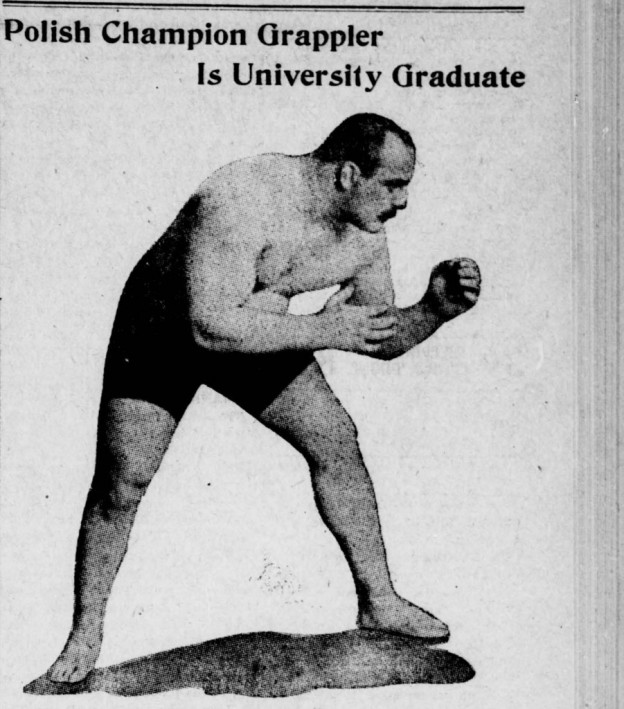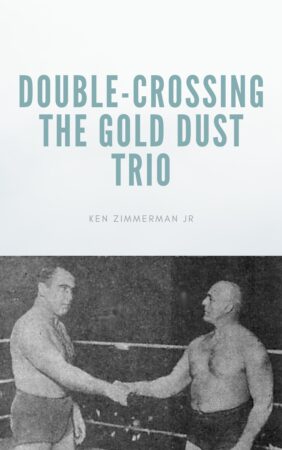A gran xogo de Stanislaus Zbyszko?
No one can question that Stanislaus Zbyszko was a great wrestler. Empezou a loitar cando o xogo aínda estaba pro dunha competencia efectiva. El continuou a ser exitosa despois do partido cambiou a traballadas (prearranged) fósforo. Centrais, participou nun concurso de rodaxe, when he legitimately defeated Big Wayne Munn for the title in 1925 cruzando os seus promotores. Despite his many accomplishments, it seems he mastered the art of hype, while he was in Europe during World War I.
When Zbyszko returned to the United States after World War I, he gave a story to the March 2, 1920 edición do El Paso Herald about a life threatening situation he faced in Russia at the hands of his bitter rival, Aleksander “Alex” Aberg. According to Zbyszko, Aberg heard Zbyszko would be performing in St. Petersburg. Fearful of a match with Zbyszko, Aberg told the Russian Army that Zbysko, a Pole from Galatia, was an Austrian spy.
The Russian army arrested Zbyszko and threatened to execute him. Stanislaus Zbyszko begged the soldiers to allow him to wrestle. The soldiers finally agreed but told him that he would be shot, if he failed to defeat Aberg. Zbyszko wrestled Aberg very carefully. After two hours and 9 actas, he threw Aberg for the defeat. After throwing Aberg, he threw a thousand rubles in the air above the startled soldiers. During the scramble for the money, Zbyszko quickly made his escape.
Two years later, when he told Robert Edgren the same story for the January 1, 1922 edición do Washington Herald, the story had changed a bit. Zbyszko and Aberg originally got along but Aberg refused to pay a debt of 600 rubles to Zbyszko. The ensuing disagreement caused Aberg to have Zbyszko arrested as an Austrian spy.
Agora, the contest lasted two hours and 43 actas. It ended by Zbyszko pinning Aberg to the mat. He again threw the 1000 rubles to the soldiers but he did not make his escape. The soldiers decided to let him go. Zbyszko wandered around Russia until the armistice was signed. Zbyszko then returned to Poland in poor health due to poor nutrition. He overate at first, which caused his later effort to get back into wrestling shape more difficult.
The truth of this fanciful yarn can not be determined. Alex Aberg was dead when Stanislaus Zbyszko started making his claims. Aberg caught pneumonia trying to emigrate from South Russia and died on February 15, 1920. Wrestling competitions ceased in Europe during 1917, so where Zbyszko would have gotten a thousand rubles is also left conjecture. Some parts of the story are difficult to believe.
Stanislaus Zbyszko had mastered the art of hype. People are interested in other people’s lives because stories connect them to a person. It is one of the reasons athletes and others spend so much money on public relations. They want to hype their athletic skills, while still making themselves seem approachable and “the next door neighbor”.
Zbyszko’s story emphasized his bravery, when faced with a life threatening situation. He also had a great foil in the Machiavellian Alex Aberg. Whether the story was true or not, it served Zbyszko’s purpose.
Zbyszko wrestled successfully for another 8 anos, although he was already in his early forties. En 1928 and almost 50 anos, Stanislaus Zbyszko retired for the second time after making a lot of money during his second run. And he left us quite a few stories as well.
You can leave a comment or ask a question about this or any post on my Facebook page.
Pin It



